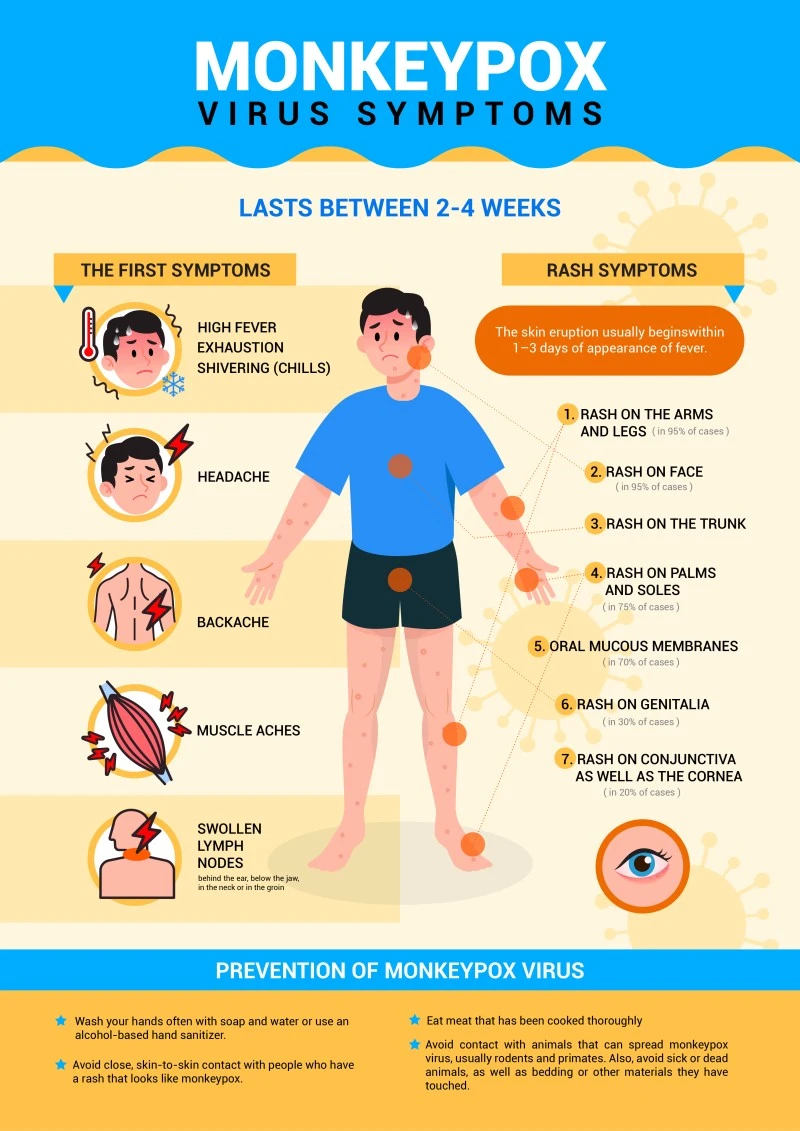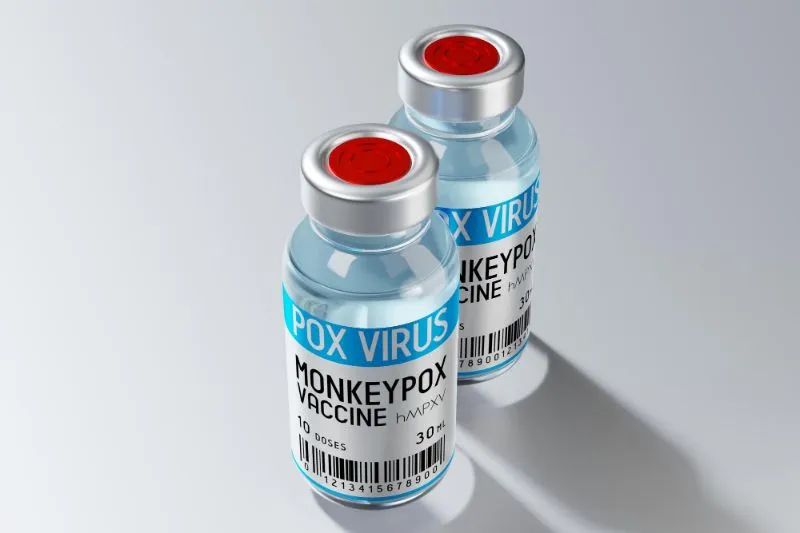Despite the remarkable progress in modern medicine, infectious diseases remain a significant global health challenge. Among them, Monkeypox (Mpox) and smallpox have profoundly impacted human health, causing substantial illness and mortality on a global scale. While smallpox has successfully been eradicated, the threat of Mpox persists in various regions worldwide, posing a significant risk to public health. This blog post will comprehensively compare these two diseases, exploring their similarities and differences and their implications for global health.
Overview of Monkeypox (Mpox) and Smallpox
Monkeypox (Mpox) and smallpox are viral diseases significantly affecting human health. Mpox, although rare, is caused by the Mpox virus, which belongs to the same virus family as smallpox, cowpox, and vaccinia. While Mpox is generally less severe than smallpox, it can still cause considerable illness and morbidity. However, it is important to note that severe cases of Mpox can occur, particularly in individuals with weakened immune systems, and can lead to complications and, in rare instances, fatalities.
In contrast, smallpox is a highly contagious and historically devastating viral disease caused by the variola virus. It holds the unfortunate distinction of being one of the deadliest diseases in human history, responsible for the deaths of millions of people worldwide. However, through rigorous global efforts, smallpox was successfully eradicated in 1980, marking a remarkable achievement in public health.
Understanding the similarities and differences between Mpox and smallpox is crucial for healthcare professionals, policymakers, and the public. By comparing these diseases, we can gain insights into their transmission patterns, clinical presentations, and potential implications for global health.
Importance of Comparing Monkeypox (Mpox) and Smallpox
The comparison of Mpox and smallpox holds significant importance due to their similarities in transmission modes and clinical symptoms. By examining these similarities, healthcare professionals can enhance their ability to diagnose cases and develop optimal treatment strategies accurately. Moreover, a comprehensive understanding of the differences between these diseases is crucial for preventing outbreaks and effectively controlling their transmission. By identifying unique characteristics and patterns, appropriate measures can be implemented to mitigate the spread of these viral infections and safeguard public health.
Origin and Historical Impact of Monkeypox (Mpox) and Smallpox
The origin and historical impact of Mpox and smallpox provide valuable insights into these diseases' global prevalence and consequences. Smallpox is believed to have emerged around 10,000 BC in Egypt, after which it rapidly disseminated across Asia, Africa, and Europe, leaving a trail of significant mortality and morbidity throughout human history. On the other hand, Mpox was first identified in 1958, originating from monkeys in Africa. It wasn't until 1970 that the first documented human case of Mpox (Mpox) occurred in the Democratic Republic of the Congo. By understanding their origins and historical impact, we can better appreciate the magnitude of these diseases and the efforts required to combat them.
Virus Responsible for Monkeypox (Mpox) and Smallpox
Mpox and smallpox, two distinct diseases, are caused by different viruses belonging to the poxvirus family. Although they share the same family, it is important to note that the Mpox virus and the variola virus responsible for smallpox have unique structural characteristics. These structural differences play a significant role in how these viruses interact with our immune system, the body's defense mechanism against infections. How a virus interacts with the immune system can greatly influence the severity of the disease and how our bodies respond to it.
The structural dissimilarity between the Mpox virus and the variola virus affects various aspects of the diseases they cause. It influences how the viruses enter our cells, replicate within our bodies, and trigger immune responses. These differences can result in variations in disease progression, clinical symptoms, and the overall outcome of the infection. Understanding these distinctions is crucial for developing accurate diagnostic tests, effective treatment approaches, and preventive measures.
Modes of Transmission for Both Diseases
Mpox and smallpox share common modes of transmission, which play a crucial role in the spread of these diseases. Mpox, like smallpox, can be transmitted to humans through direct contact with infected animals or by consuming contaminated animal products. This direct contact can occur when individuals handle or contact infected animals, such as rodents, monkeys, or other mammals.
Moreover, Mpox can also be transmitted from person to person. This occurs through respiratory droplets released when an infected individual coughs, sneezes, or talks. Additionally, transmission can occur through contact with the bodily fluids of an infected person, such as saliva, nasal secretions, or skin lesions. It is also possible for the virus to spread indirectly through contact with contaminated objects or surfaces that have been touched or contaminated by an infected individual.
Similarly, smallpox is primarily transmitted from person to person through respiratory droplets, which are expelled when an infected individual coughs or sneezes. Close contact with an infected person can lead to inhaling these respiratory droplets, facilitating the transmission of the variola virus. Additionally, contact with the bodily fluids of an infected individual, such as through direct physical contact or exposure to contaminated objects, can also contribute to the spread of smallpox.
Symptoms and Disease Progression of Smallpox
Smallpox manifests with sudden symptoms, including fever, headache, muscle aches, and vomiting. Following these initial flu-like symptoms, a distinct rash emerges. The rash undergoes a series of stages, starting as flat red spots (macules) that evolve into raised bumps (papules). Subsequently, these papules transform into fluid-filled blisters (vesicles), eventually becoming pus-filled lesions (pustules). As the pustules progress, they form scabs, finally detaching and leaving characteristic scars.
It is important to recognize that smallpox can be severe and life-threatening. In some cases, it can lead to serious complications and even death. Approximately 30% of smallpox cases result in fatalities, with individuals who have weakened immune systems being particularly vulnerable. The management of smallpox primarily involves supportive care to alleviate symptoms and minimize complications. Vaccination has played a pivotal role in preventing smallpox and reducing the severity of the disease.

Symptoms and Disease Progression of Monkeypox (Mpox)
Mpox exhibits symptoms that bear similarities to those of smallpox. Fever, headache, muscle aches, backache, swollen lymph nodes, chills, and a general sense of exhaustion mark the onset of Mpox. Subsequently, a distinctive rash appears, initially presenting as raised bumps (papules), which then progress into fluid-filled blisters (vesicles) and eventually form pus-filled lesions (pustules). This rash can affect various parts of the body.
The duration of Mpox illness typically spans from two to four weeks. Fortunately, most patients recover from the infection without experiencing complications. However, it is important to note that severe cases of Mpox can occur, particularly in individuals with weakened immune systems. These severe cases can lead to complications and may, in rare instances, result in fatalities. Prompt medical attention and appropriate supportive care are vital in managing the symptoms and ensuring the best possible outcome for individuals affected by Mpox.
Diagnostic Methods for Mpox and Smallpox
Accurate diagnosis of both Mpox and smallpox involves a combination of clinical evaluation and laboratory testing. In the case of smallpox, diagnosis primarily relies on recognizing the characteristic symptoms of the disease, such as the distinct rash and the progression of lesions from macules to pustules. Clinical observations, a thorough medical history, and a physical examination provide important indications.
To confirm the diagnosis of smallpox, laboratory tests play a crucial role. Polymerase chain reaction (PCR) testing is utilized to detect the presence of the variola virus, the causative agent of smallpox, by amplifying specific viral genetic material. Virus isolation, involving the growth of the virus in specialized laboratory settings, can further confirm the diagnosis.
Similarly, diagnosing Mpox requires a comprehensive approach. Clinical symptoms, including fever, rash, and the progression of skin lesions, are considered during evaluation. However, a definitive diagnosis based solely on clinical observation can be challenging due to similar symptoms with other viral diseases like chickenpox and measles.
Laboratory tests are employed to confirm the presence of Mpox. PCR testing can detect the genetic material of the Mpox virus in patient samples, aiding in diagnosis. Virus isolation and serologic assays, which detect specific antibodies produced in response to the virus, further confirm the Mpox diagnosis.
It is crucial to note that diagnosing both Mpox and smallpox requires expertise and access to appropriate laboratory facilities. Healthcare professionals carefully consider the clinical symptoms alongside laboratory test results to establish accurate diagnoses and differentiate these diseases from other similar viral illnesses. Combining clinical and laboratory approaches enhances the accuracy of diagnosing and managing Mpox and smallpox cases.

Treatment Approaches for Monkeypox (Mpox) and Smallpox
Currently, no specific antiviral treatment is available for either Mpox or smallpox. Therefore, the primary focus of treatment for both diseases is supportive care aimed at managing symptoms and providing relief to affected individuals.
Supportive care for Mpox involves addressing symptoms such as fever and pain. Healthcare professionals employ measures to alleviate discomfort, ensure hydration, and monitor and manage any complications that may arise. In addition to supportive care, experimental antiviral drugs such as cidofovir and brincidofovir are being investigated for their potential effectiveness against Mpox. These antiviral drugs show promise in inhibiting viral replication and reducing the severity of the disease. However, further research and evaluation are needed to determine their efficacy and safety in treating Mpox.
Similarly, treatment primarily revolves around supportive care for smallpox to alleviate symptoms and manage complications. Fever, pain management, and measures to maintain proper hydration and nutrition are crucial aspects of care. Close monitoring and appropriate medical interventions are implemented to address potential complications during the illness.
Vaccination plays a significant role in preventing smallpox and reducing its severity. Although routine smallpox vaccination is no longer administered since the disease has been eradicated. Vaccination can provide effective protection against smallpox, and historically, it has played a pivotal role in controlling the spread of the disease.
It is important to note that seeking prompt medical attention is essential for individuals suspected or confirmed to have either Mpox or smallpox. Healthcare professionals will provide appropriate supportive care, monitor the progress of the disease, and take necessary measures to manage symptoms and complications to ensure the best possible outcome for affected individuals.

Vaccination Strategies for Monkeypox (Mpox) and Smallpox
Vaccination is crucial for preventing Mpox and smallpox. Two vaccines approved by the CDC and FDA for preventing these diseases are JYNNEOS and ACAM2000. JYNNEOS is a newer vaccine that is considered to be safer than ACAM2000. It is given as two injections, four weeks apart. ACAM2000 is an older vaccine that is more effective than JYNNEOS but has more side effects. It is given as a single injection but can cause a serious rash that can spread to other body parts.
The smallpox vaccine can offer some protection against Mpox, but it is not as effective as against smallpox. The effectiveness of the smallpox vaccine against Mpox is estimated to be 85%. This means that about 15% of vaccinated people will still get Mpox if exposed to the virus.
Vaccination is important for high-risk groups like healthcare workers, people who have close contact with people infected with Mpox, and people who live in or travel to areas where Mpox is spreading. The smallpox vaccine has some restrictions. It is not recommended for pregnant people, people with a weakened immune system, or people with certain medical conditions.
Researchers are working to develop a specific vaccine for Mpox. However, it has yet to be made available. In the meantime, maintaining high vaccination coverage for smallpox is essential. This helps indirectly protect against Mpox too.
We can control and prevent their spread by ensuring people are vaccinated, closely monitoring the diseases, and taking prompt action. Vaccination plays a crucial role in safeguarding our health and preventing the devastating consequences of these diseases.
Infection Control and Prevention Recommendations for Monkeypox (Mpox) and Smallpox
Effectively preventing the spread of Mpox and smallpox necessitates implementing stringent infection control measures. These measures include strict isolation protocols for individuals diagnosed with the diseases to minimize contact with unaffected individuals. Isolation helps prevent the transmission of the viruses from infected individuals to others, thereby containing the spread.
Another vital aspect of infection control is appropriately using personal protective equipment (PPE). Healthcare professionals and individuals in close contact with infected individuals should utilize PPE, such as gloves, masks, gowns, and eye protection, to reduce the risk of direct contact with bodily fluids or respiratory droplets containing the viruses.
Additionally, timely vaccination of individuals exposed to Mpox or smallpox is crucial for preventing further transmission. Vaccination provides a protective immune response, reducing the risk of infection and minimizing the severity of the diseases in vaccinated individuals. Immediate vaccination following exposure can be instrumental in limiting the spread of these highly contagious viruses.
Furthermore, comprehensive public health strategies encompass robust surveillance systems, timely reporting of cases, contact tracing, and monitoring of individuals who have been close to infected individuals. These measures aid in identifying potential cases, implementing appropriate infection control measures, and preventing further transmission within communities.
Healthcare professionals, public health authorities, and individuals can collectively contribute to containing and mitigating Mpox and smallpox outbreaks by strictly adhering to these infection control and prevention recommendations. These measures are vital for safeguarding public health and preventing the dissemination of these infectious diseases.
Global Impact of Smallpox Eradication
The eradication of smallpox is a monumental milestone in public health, recognized as one of the most significant achievements of the twentieth century. Before its eradication in 1980, smallpox had claimed the lives of hundreds of millions of people worldwide. The successful elimination of smallpox saved countless lives and had far-reaching implications for global health.
The eradication of smallpox catalyzed advancements in vaccine development and immunization programs. It underscored the power of vaccines in preventing and controlling infectious diseases, inspiring further research and innovation in vaccine technology. Smallpox eradication paved the way for developing and deploying other life-saving vaccines, preventing numerous diseases that previously caused immense suffering and mortality.
Moreover, eradicating smallpox had a transformative effect on global health efforts. It demonstrated the feasibility of eradicating diseases through coordinated international efforts, collaboration, and widespread vaccination campaigns. This success story inspired increased investment in public health infrastructure, surveillance systems, and disease control programs worldwide. Lessons learned from the smallpox eradication campaign have been applied to tackle other infectious diseases, contributing to significant progress in disease prevention and control globally.
The impact of smallpox eradication extends beyond the eradication itself. It is a testament to the potential of determined global cooperation and concerted public health efforts to overcome even the most formidable challenges. The eradication of smallpox remains a remarkable legacy, fueling optimism and providing a blueprint for future disease-elimination endeavors.
Recent Outbreaks and Concerns Regarding Monkeypox (Mpox)
Mpox has witnessed several outbreaks in recent years, primarily in Africa, with sporadic cases reported in the United States and other countries. The occurrence of Mpox in previously unaffected regions emphasizes the importance of sustained global surveillance and preparedness efforts to respond to emerging infectious diseases effectively.
The Mpox outbreaks in Africa have raised concerns due to their potential impact on public health. These outbreaks serve as a reminder that Mpox continues to pose a significant threat, particularly in regions where the disease remains endemic. Factors such as increased international travel, urbanization, and changes in ecological dynamics can contribute to spreading the virus to new areas, necessitating heightened vigilance and preparedness measures.
The detection of isolated Mpox cases outside of Africa, including in the United States and other countries, underscores the global nature of the disease and the importance of rapid detection and response capabilities. Prompt identification, containment, and implementation of appropriate control measures are crucial to prevent further transmission and potential outbreaks in new regions.
To address these concerns, it is essential to maintain robust global surveillance systems that can detect and monitor cases of Mpox promptly. This includes enhancing laboratory diagnostics, strengthening epidemiological surveillance, and promoting knowledge-sharing and collaboration among countries. Furthermore, preparedness efforts should focus on raising awareness among healthcare professionals and the general public, ensuring the availability of necessary resources, and fostering international cooperation to respond to any future Mpox outbreaks effectively.
By remaining vigilant and proactive, global health authorities can effectively manage Mpox's challenges and minimize the disease's potential impact on public health. Continuous surveillance and preparedness efforts are vital in mitigating the spread of Mpox and promptly implementing control measures to protect communities at risk.
Conclusion
In conclusion, while smallpox has been eradicated, Mpox continues to pose a significant public health threat in many parts of the world. Comparing and contrasting these two diseases is important for understanding their similarities, differences, and implications for global health. Vaccination, infection control measures, and continued surveillance efforts are crucial for preventing outbreaks and controlling transmission. If you have any concerns regarding infectious diseases like Mpox or smallpox, it is essential to seek prompt medical attention to ensure accurate diagnosis, appropriate treatment, and timely implementation of control measures. Visit Cura4U to access various healthcare services, including telemedicine consultations with qualified physicians, diagnostic tests, and vaccination guidance. Stay informed, take proactive steps, and prioritize your health with Cura4U's comprehensive healthcare solutions.
Our clinical experts continually monitor the health and medical content posted on CURA4U, and we update our blogs and articles when new information becomes available. Last reviewed by Dr. Tayyab Saeed Akhter on July 10th, 2023.
References
A narrative review of pox: smallpox vs. Mpox | The Egyptian Journal of Internal Medicine | Full Text (springeropen.com)- https://ejim.springeropen.com/articles/10.1186/s43162-022-00174-0
A narrative review of pox: smallpox vs. Mpox - PMC (nih.gov)- https://www.ncbi.nlm.nih.gov/pmc/articles/PMC9746567/
Smallpox/Mpox Vaccine Information Statement | CDC- https://www.cdc.gov/vaccines/hcp/vis/vis-statements/smallpox-Mpox.html
Mpox (Mpox) (who.int)- https://www.who.int/news-room/fact-sheets/detail/Mpox
Smallpox and Mpox: Looking back and looking ahead | Cleveland Clinic Journal of Medicine (ccjm.org)- https://www.ccjm.org/content/90/3/141
Mpox (Mpox): Practice Essentials, Pathophysiology, Etiology (medscape.com)- https://emedicine.medscape.com/article/1134714-overview
Smallpox | CDC- https://www.cdc.gov/smallpox/index.html
Smallpox - StatPearls - NCBI Bookshelf (nih.gov)- https://www.ncbi.nlm.nih.gov/books/NBK470418/
Comparative Pathology of Smallpox and Mpox in Man and Macaques - ScienceDirect- https://www.sciencedirect.com/science/article/pii/S002199751200120X
Vaccines to prevent smallpox, mpox (Mpox), and other orthopoxviruses - UpToDate- https://www.uptodate.com/contents/vaccines-to-prevent-smallpox-mpox-Mpox-and-other-orthopoxviruses















